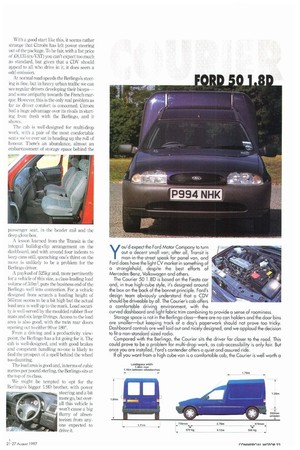T he Citroen Reding() is a rarity in the car-derived van
Page 24

Page 25

If you've noticed an error in this article please click here to report it so we can fix it.
market, because it's not actually derived from a car. A product of the PSA (Peugeot-Citroen) group. and developed at a cost of 8300m, the Berlingo is built at Citroen's Vigo factory. Peugeot markets its own version of the Berlingo under the Partner brand.
The Reding() was launched specifically to take on established players like the Ford Courier, and the fact that this is a purposedesigned CV, rather than a modified car, puts it at an immediate advantage over the competition.
Whereas Ford and Volkswagen have had to build a comparatively massive box onto the front end of their respective donor vehicles, the Berlingo maintains the same roof line from the windscreen to the rear doors.
From an aesthetic point of view this could cause prob lems, but the
Reding() is instantly recognisable—and for the sole trader who relies on his vehicle as an advertising hoarding, this may be no had thing. Also, the tall cab offers excellent access and headroom for even the largest driver. Furthermore, although we don't have the figures to prove it, a continuous n)of line, rather than the stepped arrangement used by the other two subjects of this test, should make for better aerodynamics, leading to improved stability and fuel economy. Meanwhile, the Citroen's "wheel at each corner" configuration can only help its handling. With a good start like this, it seems rather strange that Citroen has left power steering out of the package. 'lb be fair, with a list price of £8,135 (ex-VAT) you can't expect too much as standard, but given that a CDV should appeal to all who drive in it, it does seem a odd omission.
At normal road speeds the Bedingo's steering is fine, but in heavy urban traffic we can see regular drivers developing their biceps— and some antipathy towards the French marque. However, this is the only real problem as far as driver comfort is concerned. Citroen had a huge advantage over its rivals in starting from fresh with the Berlingo, and it shows.
The cab is well-designed for multi-drop work, with a pair of the most comfortable seats we've ever sat in heading up the roll of honour. There's an abundance, almost an embarrassment of storage space behind the passenger seat, in the header rail and the deep glove box.
A lesson learned from the Transit is the integral bulldog-clip arrangement on the dashboard, and with around four indents to keep cans still, quenching one's thirst on the move is unlikely to be a problem for the Berlingo driver.
A payload of 525kg and, more pertinently for a vehicle of this size, a class-leading load volume of 3.0m3, puts the business end of the Berlingo well into contention. For a vehicle designed from scratch a loading height of 567mm seems to be a bit high but the actual load area is well up to the mark. Load security is well-served by the moulded rubber floor mats and six large D rings. Access to the load area is also good, with the twin rear doors opening out to either 90 or 180°.
From a driving and a productivity viewpoint, the Berlingo has a lot going for it. The cab is well-designed, and with good brakes and competent handling no-one is likely to find the prospect of a spell behind the wheel too daunting.
The load area is good and, in terms of cubic metres per pound sterling, the Berlingo sits at the top of its class.
We might be tempted to opt for the Berlingo's bigger 1.9D brother, with power steering and a bit more go, but overall this vehicle is won't cause a big flurry of absenteeism from anyone expected to drive it.
































































































